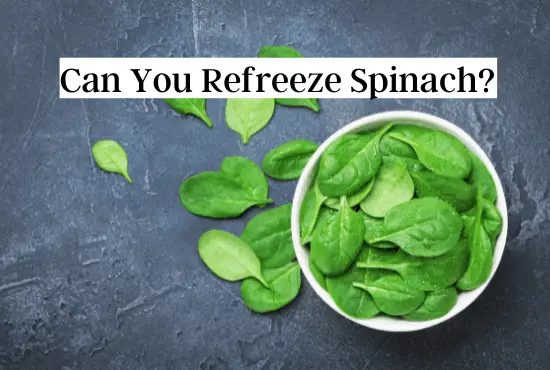Freezing Spinach is a great way to help you have Spinach on hand all year round for a variety of meal preps. Suppose you had frozen a big batch of Spinach and, while thawing, realised that you need a small portion only. You might want to pop the extra Spinach back into the freezer to save it from getting wasted. So, you might be thinking, can you refreeze Spinach?
You can safely refreeze Spinach and keep it refrozen for as long as 6 months. However, it is advised not to refreeze Spinach more than once, as that might compromise the overall quality. If you want, you can also refreeze Spinach after cooking it. Whatever way you prefer, remember refreezing is only allowed if you thaw it in a refrigerator.
Spinach doesn’t undergo a significant quality degradation if refrozen properly. To learn more about additional tips for retaining the optimum flavor of frozen Spinach, do take a look at this detailed guide.
Table of Contents
Is it Safe to Refreeze Spinach?
It is not recommended to refreeze Spinach, but refreezing won’t cause any harm to your health as long as you thaw Spinach in a refrigerator. You might notice some degradation in the overall quality after refreezing. However, the Spinach will remain safe for consumption.
It is better to refreeze Spinach if it hasn’t completely thawed. Because completely thawed Spinach might show a more significant decrease in taste, texture, and quality than partially thawed one.
In the case of slightly thawed Spinach, you can pop it back into the freezer without having to go through the fuss of repackaging. But, before popping it into the freezer, ensure the bag has no ruptures and is tightly intact.
If you want to refreeze Spinach, do not let it sit out at average room temperature (i.e., any temperature greater than 40 degrees F) for more than 2 hours. Exposure to outside air might promote bacterial growth leading to contamination.
Another thing to be mindful of is that refreezing will wash out a little bit of the nutrients as well as the flavor and texture. So, the Spinach might have compromised overall quality.
However, this doesn’t mean the Spinach has gone bad or is no longer safe for eating.
Can You Refreeze Spinach After Cooking?
It is not recommended to refreeze the Spinach if it has completely thawed or has thawed by a method other than refrigerator-thawing. Suppose you thawed Spinach on the countertop/under cold running water. In that case, you can either discard the Spinach or cook it right away before the 1-2-hour limit is crossed in such a condition.
Once you have cooked it, you can then refreeze the cooked portion. But, make sure the Spinach has cooled down before you seal the container and pop it into the freezer.
Although, cooked Spinach might not last as long as uncooked one. Still, cooking and refreezing is your best bet if you have completely thawed the Spinach. Thoroughly cooking the Spinach will also help you kill the bacteria that might have started growing while it was thawing.
How to Refreeze Spinach?
By carefully following the refreezing instruction mentioned below, you can ensure the safe refreezing of Spinach.
- In the case of uncooked Spinach, move the frozen spinach leaves into the refrigerator and wait until they have partially thawed.
- In the case of cooked Spinach, let it cool down totally before you start to pack them up inside the airtight bag/container.
- Ensuring the vegetables is important because the hot food might raise the freezer’s temperature and thaw the food present inside.
- Chop off as much of the uncooked Spinach as you need and put the remaining part on the counter.
- Divide the Spinach into meal-size portions according to your personal preference.
- Place each portion into a separate airtight bag and seal it tightly. Before you close the bag, make sure to remove as much extra air as possible.
- Put the sealed bag inside a freezer-safe bag and label it with the date of refreezing.
- After labeling the bag, place it on a flat surface inside the freezer and keep it there until you’re ready to use it.
How Long Can You Refreeze Spinach?
Properly refrozen uncooked/raw Spinach will last you almost 4-6 months. It is recommended to use Spinach as soon as possible to get the most out of it. Because the longer you wait before using it up, the greater the quality degradation will be.
On the other hand, cooked Spinach will last you 3-4 months after refreezing. Again, the sooner you consume it, the better the taste. So, it would be best if you ate it shortly after refreezing.
Although we noted these refreezing time limits to be accurate in most cases, it is best to remember that sometimes the Spinach (and all other veggies) might spoil before the estimated time limit crosses.
So, before consuming any refrozen vegetable, it is advised to carefully examine the vegetable and get rid of it on spotting any signs of spoilage.
Can You Refreeze Spinach Pie?
It is not recommended to refreeze spinach pie. The spinach pie contains ingredients that are not so freezer-friendly. So, the refrozen pie might turn excessively soggy. Moreover, the second thaw might activate the bacteria and spoil it.
Instead, if you want to store the pie for a long time, you can freeze it in portions. This way, you’ll have control over how much pie you thaw. Doing so will also help save the leftover pie from unnecessary thawing.
Freezing the pie in portions might extend its shelf life up to 2 months. Once the 2-month limit has passed, you should discard it as it may have already gone bad.
Can You Refreeze Spinach Dip?
Like various other sauces and dips, you can safely refreeze spinach dip that has thawed in a refrigerator. However, remember not to refreeze the dip more than once.
Also, ensure that the dip you want to refreeze has not been sitting out at a temperature greater than 90 degrees F for more than an hour.
A refrozen dip might show compromised taste and texture. Still, it will remain safe for usage for up to 1-2 months. However, sometimes the dip might start spoiling before the recommended time limit is due.
How to Know the Spinach Has Gone Bad?
If you need help determining whether the spinach leaves have gone bad or not, you can look for the following signs and then decide.
- Darker color – if the spinach leaves have a dull dark green color instead of having a bright, fresh green color.
- Withered and crumpled leaves – Besides the color, if you feel like the leaves have also started to fall off, or the leaves appear extremely wilted.
- Black spots/molds – if there are any molds or black spots on the surface of the spinach leaves.
- Slimy-watery texture – if you notice the spinach leaves have leaked some fluid and have become slimy.
- Lousy odor – if the spinach leaves are giving off a rotten, pungent smell.
All the signs mentioned above will help you identify when the spinach leaves have gone bad. Once you notice any of these signs, it is advised to discard the Spinach immediately.
Conclusion
Spinach is a freezer-friendly vegetable, so it tends to refreeze pretty well. Carefully refrozen raw Spinach will last you for six months. At the same time, cooked Spinach will stay safe for use for almost three months.
However, refreezing Spinach more than once will harm the overall quality. In addition, constant refreezing might also result in spoilage of Spinach. So, if you thaw the uncooked Spinach for a second time, you need to follow the refreezing process only after you cook it.
You can check out the refreezing instruction mentioned in this guide to save the thawed Spinach from getting wasted. Moreover, I have also included a list of signs to look for that will help you understand whether the Spinach is safe for use or not.


